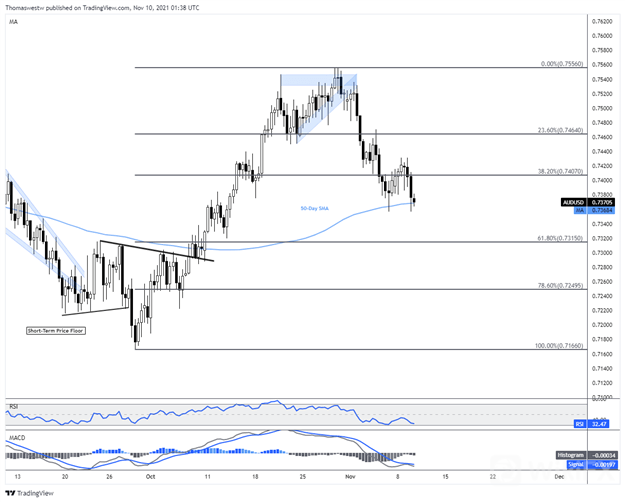-
Australian Dollar remains lower on Chinese inflation data
-
Chinas CPI and PPI gauges show increasing price pressures
-
AUD/USD is clinging to the 50-day SMA as prices drop

The Australian Dollar remained slightly lower through the Asia-Pacific session after Chinese inflation data crossed the wires. China‘s consumer price index (CPI) for October was 1.5% on a year-over-year basis, according to the National Bureau of Statistics (NBS). That was over the median consensus forecast of 1.4% y/y and up from September’s 0.7% increase.
China‘s factory-gate prices also increased in October, with the nation’s producer price index (PPI) rising 13.5% y/y, up from September‘s 10.7% rise. The higher input costs for factories come as the world deals with lingering supply chain issues from the Covid pandemic. Surging energy costs likely contributed to October’s PPI increase, with coal, oil, and natural gas prices at or near multi-year highs.
Policymakers have taken several steps in recent months to cool rising prices, ranging from allowing some previously banned Australian coal imports to clear customs to release stocks from strategic national reserves. A slowdown in China‘s property sector, which has been exacerbated by the Evergrande crisis, is also clouding the outlook for Asia’s largest economy.
The price of Fantasia Holdings – another embattled Chinese property developer – is down 50% in Hong Kong after failing to make a coupon payment due last month. The stock started trading on Wednesday for the first time since being suspended in late September. Traders will shift their focus to US inflation data due out tonight.
AUSTRALIAN DOLLAR TECHNICAL OUTLOOK
AUD/USD faces downward pressure, with prices eyeing a second daily loss. The 50-day Simple Moving Average (SMA) is underpinning the currency pair through Wednesdays session, but if that level gives way bears are likely to achieve a further push lower. For now, with MACD and RSI aiming lower, the most likely short-term path is biased to the downside.
AUD/USD 8-HOUR CHART

Source: DailyFX

Leave a Reply